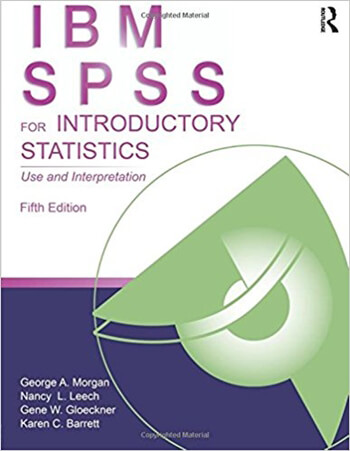This is completed downloadable of IBM SPSS for Introductory Statistics Use and Interpretation 5th Morgan Solution Manual

Product Details:
- ISBN-10 : 1848729820
- ISBN-13 : 978-1848729827
- Author: George A. Morgan, Nancy L. Leech, Gene W. Gloeckner, Karen C. Barrett
Designed to help students analyze and interpret research data using IBM SPSS, this user-friendly book, written in easy-to-understand language, shows readers how to choose the appropriate statistic based on the design, and to interpret outputs appropriately. The authors prepare readers for all of the steps in the research process: design, entering and checking data, testing assumptions, assessing reliability and validity, computing descriptive and inferential parametric and nonparametric statistics, and writing about outputs. Dialog windows and SPSS syntax, along with the output, are provided. Three realistic data sets, available on the Internet, are used to solve the chapter problems.
The new edition features:
- Updated to IBM SPSS version 20 but the book can also be used with older and newer versions of SPSS.
- A new chapter (7) including an introduction to Cronbach’s alpha and factor analysis.
- Updated Web Resources with PowerPoint slides, additional activities/suggestions, and the answers to even-numbered interpretation questions for the instructors, and chapter study guides and outlines and extra SPSS problems for the students. The web resource is located www.routledge.com/9781848729827 .
- Students, instructors, and individual purchasers can access the data files to accompany the book at www.routledge.com/9781848729827 .
IBM SPSS for Introductory Statistics, Fifth Edition provides helpful teaching tools:
- All of the key IBM SPSS windows needed to perform the analyses.
- Complete outputs with call-out boxes to highlight key points.
- Flowcharts and tables to help select appropriate statistics and interpret effect sizes.
- Interpretation sections and questions help students better understand and interpret the output.
- Assignments organized the way students proceed when they conduct a research project.
- Examples of how to write about outputs and make tables in APA format.
- Helpful appendices on how to get started with SPSS and write research questions.
An ideal supplement for courses in either statistics, research methods, or any course in which SPSS is used, such as in departments of psychology, education, and other social and health sciences. This book is also appreciated by researchers interested in using SPSS for their data analysis.
Table of Content:
- 1 Variables, Research Problems, and Questions
- Research Problems
- Variables
- Research Hypotheses and Questions
- A Sample Research Problem: The Modified High School and Beyond (HSB) Study
- Interpretation Questions
- 2 Data Coding, Entry, and Transformation
- Plan the Study, Pilot Test, and Collect Data
- Code Data for Data Entry
- Problem 2.1: Check the Completed Questionnaires
- Problem 2.2: Define and Label the Variables
- Problem 2.3: Display Your Dictionary or Codebook
- Problem 2.4: Enter Data
- Alternative Problem 2.4: Downloading and Using Data Collected Online
- Problem 2.5: Count Math Courses Taken
- Problem 2.6: Recode and Relabel Mother’s and Father’s Education
- Problem 2.7: Reverse Low Pleasure Items for Pleasure Scale Score
- Problem 2.8: Compute Pleasure Scale with the Mean Function
- Problem 2.9: Check for Errors and Normality for the New Variables
- Describing the Sample Demographics and Key Variables
- Using Figures to Help Describe the Data
- Saving the Updated HSB Data File
- Interpretation Questions
- Extra SPSS Problems
- 3 Measurement and Descriptive Statistics
- Frequency Distributions
- Levels of Measurement
- Descriptive Statistics and Plots 54
- The Normal Curve
- Interpretation Questions
- Extra SPSS Problems
- 4 Understanding Your Data and Checking Assumptions
- Exploratory Data Analysis (EDA)
- Problem 4.1: Descriptive Statistics for the Ordinal and Scale Variables
- Problem 4.2: Boxplots for One Variable and for Multiple Variables
- Problem 4.3: Boxplots and Stem-and-Leaf Plots Split by a Dichotomous Variable
- Problem 4.4: Descriptives for Dichotomous Variables
- Problem 4.5: Frequency Tables for Each Type of Variable
- Interpretation Questions
- Extra SPSS Problems
- 5 Selecting and Interpreting Inferential Statistics
- General Design Classifications for Difference Questions
- Selection of Inferential Statistics
- The General Linear Model
- Interpreting the Results of a Statistical Test
- An Example of How to Select and Interpret Inferential Statistics
- Writing About Your Outputs
- Conclusion
- Interpretation Questions
- 6 Methods to Provide Evidence for Reliability and Validity
- Measurement Reliability
- Measurement Validity
- Problem 6.1: Cohen’s Kappa to Assess Reliability with Nominal Data
- Problem 6.2: Correlation and Paired t to Assess Interrater Reliability
- Problem 6.3: Exploratory Factor Analysis to Assess Evidence for Validity
- Problem 6.4: Cronbach’s Alpha to Assess Internal Consistency Reliability
- The Use of Factor Analysis and Alpha to Make Summated Scales
- Interpretation Questions
- Extra SPSS Problems
- 7 Cross-Tabulation, Chi-Square, and Nonparametric Measures of Association
- Problem 7.1: Chi-Square and Phi (or Cramer’s V)
- Problem 7.2: Risk Ratios and Odds Ratios
- Problem 7.3: Other Nonparametric Associational Statistics
- Problem 7.4: Eta
- Interpretation Questions
- Extra SPSS Problems
- 8 Correlation and Regression
- Problem 8.1: Scatterplots to Check the Assumption of Linearity
- Problem 8.2: Bivariate Pearson and Spearman Correlations
- Problem 8.3: Correlation Matrix for Several Variables
- Problem 8.4: Bivariate or Simple Linear Regression
- Problem 8.5: Multiple Regression
- Interpretation Questions
- Extra SPSS Problems
- 9 Comparing Groups with t Tests, Analysis of Variance (ANOVA), and Similar Nonparametric Tests Nonparametric Tests
- Problem 9.1: One-Sample t Test
- Problem 9.2: Independent Samples t Test
- Problem 9.3: The Nonparametric Mann-Whitney U Test
- Problem 9.4: Paired Samples t Test
- Problem 9.5: Nonparametric Wilcoxon Test for Two Related Samples
- Problem 9.6: One-Way (or Single Factor) ANOVA
- Problem 9.7: Post Hoc Multiple Comparison Tests
- Problem 9.8: Nonparametric Kruskal-Wallis Test
- Problem 9.9: Two-Way (or Factorial) ANOVA
- Interpretation Questions
- Extra SPSS Problems
- Appendices
- A. Getting Started and Other Useful SPSS Procedures
- B. Writing Research Problems and Questions
- C. Answers to Odd Numbered Interpretation Questions
- D. Glossary
- For Further Reading
- Index





